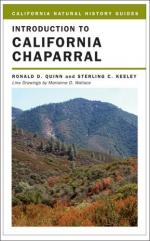|
This section contains 242 words (approx. 1 page at 300 words per page) |
Chaparral is a geographically widespread ecosystem (or biome) occurring in warm-temperate environments with a "Mediterranean" climatic regime, characterized by mild, cool, moist winters and hot, dry summers. Chaparral is a shrub-dominated ecosystem, particularly by species with evergreen, waxy, thick (or sclerophyllous), drought-resistant foliage. The shrub canopy is 3-13 ft (1-4 m) tall, sometimes with intertwining branches among closely-spaced plants. Periodic wildfires during the dry season are an important environmental influence on the structure of the chaparral ecosystem.
Chapparal vegetation is most widespread in coastal California and northwestern Mexico, in the vicinity of the Mediterranean Sea in southern Europe, and in smaller areas in southern Australia, Chile, and South Africa. Although different species of plants dominate the chaparral biome in each of these widely separated regions, they are all of a rather similar growth form, because they have evolved in response to similar regimes of natural selection (this is known as convergent evolution).
More than 100 species of shrubs occur in chaparral communities in California (plus many other kinds of plants and animals). The most widely distributed species of shrub is chamise (Adenostoma fasciculatum). On drier sites it is commonly joined by species of manzanita (Arctostaphylos spp.) and buckbrush (Ceanothus spp.). On moister sites, associated species include scrub oak (Quercus dumosa), chaparral holly (Heteromeles arbutifolia), chaparral cherry (Prunus ilicifolia), mountain mahogany (Cercocarpus betuloides), redberry and coffeeberry (Rhamnus spp.), silk-tassel bush (Garrya spp.), lemonadeberry and sugarbush (Rhus spp.), and laurel sumac (Malosma laurina).
|
This section contains 242 words (approx. 1 page at 300 words per page) |


